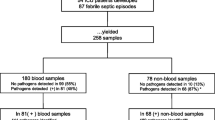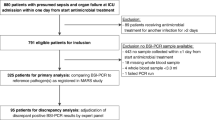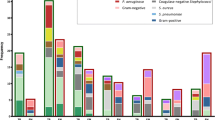Abstract
The commercial polymerase chain reaction (PCR) test, SeptiFast, is designed to identify the DNA of individual bacterial and fungal pathogens in whole blood. We aimed to evaluate the usefulness of the test for the detection of community-onset bloodstream infections. We prospectively included adult patients who were subjected to blood culture (BC) at an infectious diseases department. For the evaluation, one BC/PCR set (two BC bottles and one PCR tube) per patient was used. When several sets were obtained and analyzed, the first set with any positive result was evaluated. Among 1,093 consecutively included patients, BC was positive in 138 and PCR was positive in 107. Fifty positive PCR results were supported by BC in the same BC/PCR set, ten were supported by other cultures, and, additionally, ten were supported by the clinical presentation. Compared with BC, PCR showed specificities and negative predictive values of >97% for all detectable pathogens. The following sensitivities and positive predictive values (PPVs) were noted: Staphylococcus aureus, 67% and 43%; Streptococcus pneumoniae, 12% and 67%; other Streptococcus species, 43% and 77%; Escherichia coli, 53% and 56%; and Klebsiella species, 43% and 23%. If support from other cultures and the clinical presentation were included in the reference standard, the PPVs for the detection of these bacteria were 57%, 100%, 92%, 75%, and 69%, respectively. Although the specificities were high, the low sensitivities and suboptimal PPVs noted in the present study discourage routine use of the test in its present form for the detection of community-onset bloodstream infections.
Similar content being viewed by others
References
Kumar A, Roberts D, Wood KE, Light B, Parrillo JE, Sharma S, Suppes R, Feinstein D, Zanotti S, Taiberg L, Gurka D, Kumar A, Cheang M (2006) Duration of hypotension before initiation of effective antimicrobial therapy is the critical determinant of survival in human septic shock. Crit Care Med 34(6):1589–1596
Beekmann SE, Diekema DJ, Chapin KC, Doern GV (2003) Effects of rapid detection of bloodstream infections on length of hospitalization and hospital charges. J Clin Microbiol 41(7):3119–3125
Kollef MH, Sherman G, Ward S, Fraser VJ (1999) Inadequate antimicrobial treatment of infections: a risk factor for hospital mortality among critically ill patients. Chest 115(2):462–474
Ibrahim EH, Sherman G, Ward S, Fraser VJ, Kollef MH (2000) The influence of inadequate antimicrobial treatment of bloodstream infections on patient outcomes in the ICU setting. Chest 118(1):146–155
Peters RP, van Agtmael MA, Danner SA, Savelkoul PH, Vandenbroucke-Grauls CM (2004) New developments in the diagnosis of bloodstream infections. Lancet Infect Dis 4(12):751–760
Schrenzel J (2007) Clinical relevance of new diagnostic methods for bloodstream infections. Int J Antimicrob Agents 30(Suppl 1):S2–S6
Mancini N, Carletti S, Ghidoli N, Cichero P, Burioni R, Clementi M (2010) The era of molecular and other non-culture-based methods in diagnosis of sepsis. Clin Microbiol Rev 23(1):235–251
Meier A, Persing DH, Finken M, Böttger EC (1993) Elimination of contaminating DNA within polymerase chain reaction reagents: implications for a general approach to detection of uncultured pathogens. J Clin Microbiol 31(3):646–652
Lehmann LE, Hunfeld KP, Emrich T, Haberhausen G, Wissing H, Hoeft A, Stüber F (2008) A multiplex real-time PCR assay for rapid detection and differentiation of 25 bacterial and fungal pathogens from whole blood samples. Med Microbiol Immunol 197(3):313–324
Murray PR, Baron EJ, Jorgensen JH, Pfaller MA, Yolken RH (2003) Manual of clinical microbiology, 8th edn. ASM Press, Washington, DC
Lau A, Chen S, Sorrell T, Carter D, Malik R, Martin P, Halliday C (2007) Development and clinical application of a panfungal PCR assay to detect and identify fungal DNA in tissue specimens. J Clin Microbiol 45(2):380–385
Abdeldaim G, Herrmann B, Mölling P, Holmberg H, Blomberg J, Olcén P, Strålin K (2010) Usefulness of real-time PCR for lytA, ply, and Spn9802 on plasma samples for the diagnosis of pneumococcal pneumonia. Clin Microbiol Infect 16(8):1135–1141
Hall KK, Lyman JA (2006) Updated review of blood culture contamination. Clin Microbiol Rev 19(4):788–802
Kassis C, Rangaraj G, Jiang Y, Hachem RY, Raad I (2009) Differentiating culture samples representing coagulase-negative staphylococcal bacteremia from those representing contamination by use of time-to-positivity and quantitative blood culture methods. J Clin Microbiol 47(10):3255–3260
Mancini N, Clerici D, Diotti R, Perotti M, Ghidoli N, De Marco D, Pizzorno B, Emrich T, Burioni R, Ciceri F, Clementi M (2008) Molecular diagnosis of sepsis in neutropenic patients with haematological malignancies. J Med Microbiol 57(Pt 5):601–604
von Lilienfeld-Toal M, Lehmann LE, Raadts AD, Hahn-Ast C, Orlopp KS, Marklein G, Purr I, Cook G, Hoeft A, Glasmacher A, Stüber F (2009) Utility of a commercially available multiplex real-time PCR assay to detect bacterial and fungal pathogens in febrile neutropenia. J Clin Microbiol 47(8):2405–2410
Varani S, Stanzani M, Paolucci M, Melchionda F, Castellani G, Nardi L, Landini MP, Baccarani M, Pession A, Sambri V (2009) Diagnosis of bloodstream infections in immunocompromised patients by real-time PCR. J Infect 58(5):346–351
Casalta JP, Gouriet F, Roux V, Thuny F, Habib G, Raoult D (2009) Evaluation of the LightCycler SeptiFast test in the rapid etiologic diagnostic of infectious endocarditis. Eur J Clin Microbiol Infect Dis 28:569–573
Lamoth F, Jaton K, Prod’hom G, Senn L, Bille J, Calandra T, Marchetti O (2010) Multiplex blood PCR in combination with blood cultures for improvement of microbiological documentation of infection in febrile neutropenia. J Clin Microbiol 48(10):3510–3516
Louie RF, Tang Z, Albertson TE, Cohen S, Tran NK, Kost GJ (2008) Multiplex polymerase chain reaction detection enhancement of bacteremia and fungemia. Crit Care Med 36(5):1487–1492
Tsalik EL, Jones D, Nicholson B, Waring L, Liesenfeld O, Park LP, Glickman SW, Caram LB, Langley RJ, van Velkinburgh JC, Cairns CB, Rivers EP, Otero RM, Kingsmore SF, Lalani T, Fowler VG, Woods CW (2010) Multiplex PCR to diagnose bloodstream infections in patients admitted from the emergency department with sepsis. J Clin Microbiol 48(1):26–33
Avolio M, Diamante P, Zamparo S, Modolo ML, Grosso S, Zigante P, Tosoni N, De Rosa R, Stano P, Camporese A (2010) Molecular identification of bloodstream pathogens in patients presenting to the emergency department with suspected sepsis. Shock 34(1):27–30
Westh H, Lisby G, Breysse F, Böddinghaus B, Chomarat M, Gant V, Goglio A, Raglio A, Schuster H, Stüber F, Wissing H, Hoeft A (2009) Multiplex real-time PCR and blood culture for identification of bloodstream pathogens in patients with suspected sepsis. Clin Microbiol Infect 15(6):544–551
Acknowledgments
The study was made possible by a research grant from the Research Committee of the County Council of Örebro.
Reagents and means for technical assistance for the study were provided by Roche Diagnostics.
There has been no other financial relationship with any other company.
Conflict of interest
The authors declare that they have no conflict of interest.
Author information
Authors and Affiliations
Corresponding author
Rights and permissions
About this article
Cite this article
Josefson, P., Strålin, K., Ohlin, A. et al. Evaluation of a commercial multiplex PCR test (SeptiFast) in the etiological diagnosis of community-onset bloodstream infections. Eur J Clin Microbiol Infect Dis 30, 1127–1134 (2011). https://doi.org/10.1007/s10096-011-1201-6
Received:
Accepted:
Published:
Issue Date:
DOI: https://doi.org/10.1007/s10096-011-1201-6




